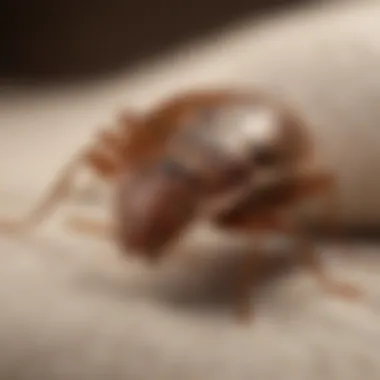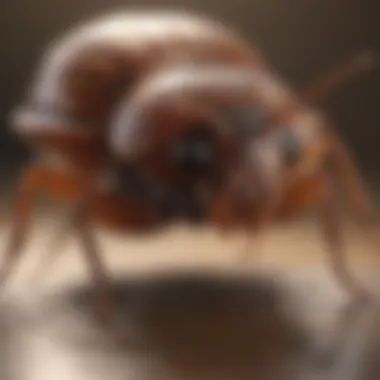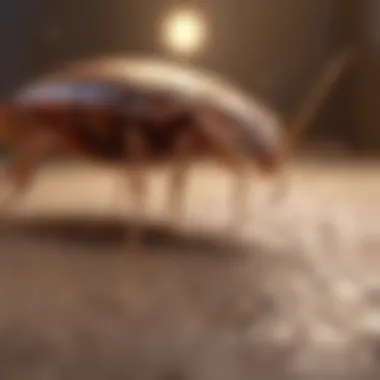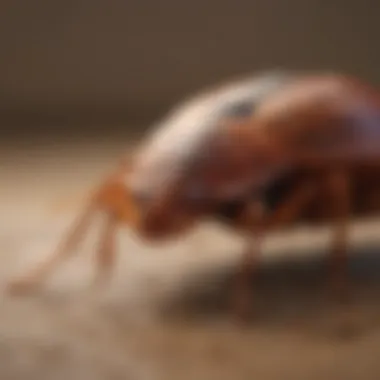Effective Strategies to Cure Bed Bugs at Home


Intro
Bed bugs are a pervasive issue in many homes today. These small, elusive creatures can disrupt sleep and create unease among residents. With increasing reports of infestations, it is crucial for homeowners to understand the nature of bed bugs and the best methods to address them. This guide presents a thorough overview of effective strategies and tools for managing these pests in a residential space. Through research-backed insights, readers can equip themselves to confront this challenge head-on.
Animal Overview
Common Names
Bed bugs, scientifically known as Cimex lectularius, are often referred to simply as bed bugs. Their habits and behaviors are well-known, making them a common concern among homeowners.
Scientific Classification
Bed bugs belong to the kingdom Animalia, phylum Arthropoda, and class Insecta. They fall under the order Hemiptera and the family Cimicidae. This classification highlights their relation to other insects that share similar characteristics, including their feeding habits.
Geographic Range
These insects are found widely across various regions. They thrive in human habitats and can be present in cities as well as rural areas. The ability to spread easily through travel makes them a global concern. Understanding their geographic distribution is vital for prevention and control.
Behavior and Social Structure
Social Behavior
Bed bugs exhibit solitary behavior and are most active at night. They tend to harbor in close proximity to their food sources, usually sleeping areas, which leads to higher infestation rates in homes. Their ability to hide in small crevices makes detection difficult, further complicating eradication efforts.
Communication
Bed bugs rely on chemical signals, known as pheromones, to communicate with each other. These signals can indicate alarm or attract mates. Understanding their communication methods can help in identifying infestations sooner.
Mating and Reproduction
Mating is a crucial aspect of bed bug life. Females can lay numerous eggs in their life, which can accelerate population growth in a short period. Under ideal conditions, a single female can produce hundreds of offspring, leading to rapid infestations if not controlled.
Habitat and Ecosystem
Natural Habitat
Bed bugs typically inhabit areas where humans dwell. They prefer warm environments, often found in mattresses, bedding, and upholstered furniture. Their choice of habitat makes them particularly problematic for homeowners.
Food Sources and Diet
Bed bugs feed exclusively on the blood of their hosts. Their feeding process usually occurs at night when they are most active. A successful feeding session can last anywhere from three to ten minutes, allowing them to ingest enough blood for nourishment.
Role in Ecosystem
In the ecosystem, bed bugs do not have a significant role. They are parasites that thrive on their hosts without contributing to the environment in a productive way. Their presence can disrupt human life, highlighting the need for effective control measures.
Understanding bed bugs and their habits is the first step towards effective management.
The following sections will delve deeper into actionable strategies to deal with bed bug infestations at home, as well as preventative measures to ensure peace of mind.
Intro to Bed Bugs
Bed bugs have emerged as significant nuisances in many households, leading to discomfort and anxiety for those infested. It is essential to grasp a clear understanding of these pests to effectively tackle the problem. This section introduces the reader to bed bugs, shedding light on their behavior, biology, and the implications of their presence in homes. Knowing which pests you are dealing with can inform better strategies for eradication and prevention.
Understanding Bed Bugs
Bed bugs, scientifically known as Cimex lectularius, are small, oval, brownish insects that feed exclusively on the blood of people and animals. They are often mistaken for other insects due to their size, which usually ranges from 1 to 5 millimeters in length. In their juvenile stages, they appear much smaller, making them harder to detect. Bed bugs are nocturnal creatures, preferring to come out at night to feed when their hosts are asleep.
A key feature of bed bugs is their ability to survive several months without feeding, which makes them particularly difficult to eliminate once they invade a home. This hardiness necessitates an informed approach to tackling infestations.


Some people may not know that bed bugs do not carry diseases, but their bites can lead to itchy welts and severe allergic reactions. The psychological impact of being infested can also be significant, causing stress and sleep disturbances for affected individuals.
Life Cycle of Bed Bugs
Understanding the life cycle of bed bugs is crucial for developing effective treatment strategies. Bed bugs undergo several stages of development, starting from eggs to adulthood. The egg stage lasts about a week, after which nymphs hatch. Nymphs molt multiple times before maturing, with each stage requiring blood meals to proceed to the next.
The entire life cycle of a bed bug can take as little as four weeks under optimal conditions, although in cooler environments, it may take longer. The life cycle comprises several distinct phases:
- Eggs
- Nymphs
- Adults
- These tiny, white eggs are often hidden in crevices, mattresses, and furniture.
- After hatching, nymphs begin their life hungry for blood. They must feed several times to molt into the next stage.
- The adult bed bug has a wider body and can reproduce quickly, making infestations escalade rapidly.
Due to this rapid reproduction, it is imperative to act promptly when signs of bed bugs are detected.
Key insights: Early detection and treatment can prevent major infestations from occurring. Continuous monitoring for signs of bed bugs ensures a proactive approach in managing and eliminating these pests.
Identifying a Bed Bug Infestation
Identifying a bed bug infestation is crucial to effectively manage and eradicate these pests from your home. Bed bugs are notorious for their ability to hide and reproduce quickly. Early detection increases the chances of successful elimination and minimizes the likelihood of spreading the problem across your living space. Addressing an infestation promptly helps in maintaining a healthy environment, avoiding sleepless nights, and preventing potential health impacts associated with prolonged exposure to bed bugs.
Signs of Bed Bug Presence
When trying to determine whether bed bugs have invaded your home, knowing the signs is essential. Early inspection can save you considerable effort and money. Some common indicators include:
- Bite Marks: In many cases, individuals may develop itchy welts or bites on exposed skin, often appearing in lines or clusters.
- Blood Stains: These pests may leave small blood stains on bed linens or mattresses after feeding.
- Fecal Spots: Dark, small spots on bedding, mattresses, or walls can indicate bed bug waste, which is a significant sign of their presence.
- Eggs and Shed Skins: Bed bug eggs, which are tiny and white, can often be found in hidden areas. Shed skins, which they leave behind as they mature, are also a clear indicator of an infestation.
Regular visual checks can help catch an infestation early and aid in devising appropriate treatments.
Common Hiding Spots
Bed bugs are expert hiders. Knowing their preferred locations can facilitate quicker detection and eradication. Some common hiding spots include:
- Mattresses and Box Springs: The seams and folds are popular areas for bed bugs to reside.
- Bed Frames: They often hide in crevices or joints where the frame is assembled.
- Furniture: Couches, chairs, and even electrical outlets can harbor bed bugs, making thorough inspections necessary.
- Luggage: When traveling, bed bugs can hitch a ride in luggage, so checking your belongings is advisable.
Identifying and understanding these signs and hiding spots is integral to effectively combating bed bugs. By recognizing the presence of these pests early, you can take action before they multiply and create a more significant problem.
Initial Steps for Eradication
In addressing a bed bug infestation, the initial steps for eradication are critical. These steps set the foundation for all subsequent actions, ensuring the process is systematic and effective. Understanding the importance of an organized approach to dealing with this common household pest cannot be overstated. Proper assessment and preparation can save time, resources, and effort in the long run.
Assessing the Situation
Before taking any drastic measures, it is imperative to assess the situation thoroughly. This involves identifying the extent of the infestation. A simple visual inspection may not provide the complete picture.
- Inspect the Premises: Start by examining areas where bed bugs typically reside, such as beds, furniture, and baseboards. Look for signs like small blood stains, shed skin, or live insects.
- Evaluate the Severity: Determine how widespread the infestation is. This involves checking not just the bedroom but other areas such as the living room and even behind wall art. Understanding the level of infestation will influence your choice of treatment.
- Document Findings: It is beneficial to document what is found during the inspection. Take photos and notes on locations and severity. This can aid in planning the next steps and may be helpful if you seek professional assistance later.
Remember, failure to properly assess the situation can lead to underestimating the problem and ineffective treatment strategies.
Gathering Necessary Supplies
After assessing the situation, the next logical step is gathering necessary supplies. The right tools can make a significant difference in the success of your eradication efforts.
- Protective Gear: Wear gloves and a mask to avoid contact with allergens or chemicals.
- Cleaning Supplies: A vacuum cleaner with a HEPA filter is essential. It should be used to remove eggs, nymphs, and adults effectively.
- Steam Cleaner: A steam cleaner can help kill bed bugs on contact. Ensure that it reaches temperatures above 130°F.
- Diatomaceous Earth: This natural product can be spread in affected areas to dehydrate and eliminate bed bugs.
- Spray Solutions: There are various insecticides available that target bed bugs specifically. Research and select a product that is safe for indoor use.
Always follow the instructions provided with any pest control product, as misuse can lead to ineffectiveness or harmful outcomes.
- Sealed Bags: Prepare bags or containers for items that can be treated, such as linens and clothing, to prevent re-infestation.


Having the right supplies on hand will empower you to act promptly and efficiently against bed bugs.
DIY Bed Bug Treatments
DIY bed bug treatments are an essential part of managing these irritating pests effectively at home. This section explores practical techniques and tools for individuals who prefer hands-on approaches. The significance of engaging in DIY treatments stems from the potential financial savings and the empowerment it offers homeowners to take control of their living space. It is crucial to determine the most effective methods as the presence of bed bugs can lead to sleep disruption and stress. Collaboration between household members enhances efficacy. Inspecting the affected areas and developing a strategic plan is the foundation of a successful eradication effort.
Steam Cleaning Techniques
Steam cleaning is highly effective in dealing with bed bugs. The high temperature of steam kills bed bugs and their eggs on contact. It is recommended to use a steamer with a nozzle attachment for targeted treatment. When using a steam cleaner, ensure the steam temperature reaches at least 120°F. Focus on seams and folds in mattresses, box springs, and upholstered furniture. Slow movement allows the heat to penetrate the surfaces better.
- Advantages of Steam Cleaning:
- Environmentally friendly, as it relies on heat instead of chemicals.
- Effective at killing bed bugs at all life stages.
- Leaves surfaces damp, making it less inviting for pests.
However, steam cleaning requires time and patience. The equipment can be costly if purchased. Regular monitoring is important after treatment to ensure that no bed bugs remain.
Vacuuming Strategies
Vacuuming plays a pivotal role in any DIY bed bug treatment plan. It can significantly reduce the number of bed bugs before applying more permanent solutions. Use a vacuum that has strong suction and consider attachments for the best results. Pay particular attention to cracks, crevices, and other potential hiding spots.
- Key Vacuuming Tips:
- Use a vacuum with a HEPA filter to trap bed bugs and their eggs effectively.
- Vacuum daily until the problem is significantly reduced.
- Empty the vacuum bag or canister outside your home immediately after vacuuming.
It is important to remember that vacuuming alone will not eliminate the infestation. It works best as part of a multi-faceted approach to eradication.
Use of Diatomaceous Earth
Diatomaceous earth (DE) is a natural pest control option that can assist in eliminating bed bugs. It is composed of fossilized algae and works by damaging the bed bugs' exoskeletons, leading to dehydration.
- How to Use Diatomaceous Earth Effectively:
- Sprinkle a thin layer on areas where bed bugs are likely to hide, including under the bed, along bed frames, and in cracks.
- Allow the DE to sit for several days for maximum effect.
- Vacuum the area thoroughly after a week.
It is essential to use food-grade diatomaceous earth, as other types may contain harmful contaminants. This treatment is a low-cost option and, when used alongside others, can help manage and control bed bug populations.
Chemical Solutions
Chemical solutions can be effective in combating bed bugs when used correctly. There are numerous commercial insecticides available. When selecting a chemical treatment, read labels carefully for effectiveness against bed bugs specifically. Products containing pyrethroids are commonly utilized. Always follow the manufacturer's instructions for safe application.
- Considerations:
- Apply chemicals in recommended dosages and areas only.
- Ensure proper ventilation during application for safety.
- Monitor for any allergic reactions in pets or family members.
Combining chemical treatments with other methods enhances the likelihood of complete eradication. It is essential to remain vigilant and conduct follow-up inspections to confirm that the infestation has been fully eliminated.
Professional Bed Bug Removal
Professional bed bug removal is a crucial consideration when addressing bed bug infestations in homes. While various DIY methods exist, the complexity and resilience of bed bugs often necessitate specialized intervention. When infestations are severe, the need for professional assistance becomes evident due to the efficacy, safety, and thoroughness that trained pest control experts provide.
Hiring professionals can save time, effort, and can lead to a more successful eradication of bed bugs.
When to Seek Help
Recognizing when to call for professional pest control is vital for effective management of bed bug infestations. Consider contacting experts if:
- High Infestation Levels: Visual evidence suggests the presence of a large number of bed bugs. If bites increase or if you find numerous eggs and exoskeletons, the situation is likely beyond DIY treatments.
- Multiple Rooms Affected: An infestation that spreads beyond one room warrants professional intervention. Bed bugs can travel through walls and floors, complicating eradication efforts.
- Ineffective DIY Treatments: If home remedies and initial attempts at eradication do not yield results after several weeks, it is time to consult a professional. Bed bugs can develop resistance to certain treatments, making expert knowledge and advanced tools essential.
- Health Concerns: In cases where bites lead to allergic reactions or exacerbate health issues, seeking help is urgent. Professionals can address these issues while ensuring that the treatment is conducted safely.
Types of Pest Control Services
There are several pest control options available for tackling bed bugs. Choosing the right type of service can significantly impact the outcome of your bed bug management efforts. Here are the common types of services:


- Chemical Treatments: Specialists use pesticides specifically formulated to eliminate bed bugs. This method may require multiple visits to ensure thorough eradication. Clients are often advised to vacate the premises during treatment.
- Heat Treatments: This approach involves raising the temperature in infested rooms to levels that are lethal to bed bugs and their eggs. This method is less reliant on chemicals but requires specialized equipment.
- Steam Treatment: Similar to heat treatments but applied through steam. It is effective for killing bed bugs on contact, particularly on surfaces like mattresses and couches.
- Integrated Pest Management (IPM): An eco-friendly approach that combines various strategies, including inspections, monitoring, and the use of multiple treatment methods. This option focuses on long-term prevention rather than temporary solutions.
- Canine Inspections: Some services employ trained dogs to locate bed bugs, known for their accuracy. Dogs can often detect infestations even when they're hard to spot visually.
Choosing the right pest control service depends on the severity of the infestation, budget, and preferences regarding chemical exposure. Understanding these considerations is essential for effective bed bug management.
Preventing Future Infestations
Preventing future infestations is crucial when dealing with bed bugs. Once they infiltrate your home, they can quickly become a significant problem. Effective prevention methods can save you from costly extermination processes and ensure your living environment remains comfortable and safe. Addressing the steps needed to prevent bed bugs can reinforce existing treatments or serve as a primary strategy for those who have been previously affected.
Regular Inspections
Conducting regular inspections can help catch potential infestations early. You should check areas where bed bugs might hide, such as under mattresses, within cracks of bed frames, and along baseboards. The process of inspecting does not take much time but requires thoroughness.
- Frequency of Inspections: Set a schedule for inspections—weekly or monthly, based on your situation. Consistency is key.
- What to Look For: Look for signs of bed bugs, such as small brownish stains on bedding or shed skins near sleeping areas.
- Involving Others: If you share your living space, involve others. They should also know when to inspect.
Incorporating inspections into your routine allows you to maintain awareness of your surroundings and take action before bed bugs become an issue.
Protective Measures for Bedding
Taking protective measures for bedding is essential. Encasing your mattress and box spring in bed bug-proof covers can act as a barrier against these pests.
- Choice of Covers: Use covers that are certified by entomologists. These covers should be tear-resistant and have zippers that can prevent bed bugs from escaping.
- Regular Washing: Additionally, wash your bedding regularly in hot water. Heat helps to kill any potential bugs or eggs that might be present.
- Reduce Clutter: Keeping bedding and bedroom areas free from unnecessary clutter will minimize hiding spots and make it easier to inspect.
Maintaining cleanliness in these areas discourages bed bugs from settling in, reducing the chances of future infestations.
Travel Tips to Avoid Bed Bugs
Traveling can be an opportunity to unknowingly transport bed bugs back to your home. You must take precautions when away from your residence.
- Hotel Checks: Before settling into a hotel, inspect the room. Pull back bedding and check mattress seams.
- Luggage Strategies: Place your luggage on a luggage rack instead of the bed. Keeping bags off of furniture can help avoid accidental transfers.
- Post-Trip Actions: After returning home, vacuum your luggage and wash all clothing immediately in hot water.
By practicing these travel tips, you can minimize the risk of bed bugs entering your living space. Staying vigilant during your travels is necessary for long-term peace of mind.
Be Aware: A small effort in prevention can save you a lot of hassle down the road. Incorporate these practices into your routine, and you will significantly reduce your chances of future infestations.
Documents and Resources
The inclusion of documents and resources in this article provides a critical layer of support for individuals seeking to combat bed bug infestations effectively. Through a well-curated selection of references, readers can explore an array of evidence-based strategies and recommendations, thus enriching their understanding of the subject. This section serves as a compass, guiding individuals toward credible sources that can offer additional insights, verification of claims, and practical steps for removing bed bugs.
Engaging with the right documents not only enhances knowledge but also empowers people to tackle the problem more systematically. The quality and reliability of information can make a significant difference in the eradication efforts. It is beneficial to consider factors such as the credibility of the sources, the recency of the information, and the specificity to personal situations when leveraging these resources.
Links to Government Resources
Government resources provide vital information regarding pest control and public health. Agencies such as the Centers for Disease Control and Prevention (CDC) and the Environmental Protection Agency (EPA) offer comprehensive guidelines and updates about proper methods for dealing with bed bugs. Key advantages of using these resources include:
- Authoritative Information: Government sites typically base their recommendations on scientific research and peer-reviewed studies.
- Safety Guidelines: Properly handling chemicals and treatments requires adherence to safety protocols outlined by these organizations.
- Local Assistance: Many government resources offer contacts for local pest control services or health departments that can help those facing infestations.
To access reliable information regarding bed bug control, visit the EPA’s Bed Bug Page or the CDC's Bed Bug Resources.
Recommended Books and Guides
In addition to online resources, there exists a wealth of literature dedicated to the methodology of bed bug eradication. Books and guides by pest experts can assist individuals in understanding complex topics in a more digestible format. Some noteworthy resources include:
- **
Ending
Addressing a bed bug infestation requires diligence and a methodical approach. The importance of this conclusion lies in consolidating the knowledge obtained throughout the article. It emphasizes the realities of controlling bed bugs, providing readers with a summarization of essential methods, and reinforcing the significance of thoroughness in every step. Understanding and applying these strategies can greatly alleviate the distress caused by these pests.
Recap of Key Points
- Understanding Bed Bugs: Recognizing what bed bugs are and their life cycle is foundational.
- Identifying Infestation: Effectively spotting the signs of bed bug presence and their common hiding spots is critical.
- Initial Steps for Eradication: Before engaging in treatment options, assessing the severity of the issue and gathering necessary supplies is paramount.
- DIY Treatments: Techniques such as steam cleaning, vacuuming, and using diatomaceous earth are accessible and often effective.
- Professional Help: Knowing when to seek help from pest control professionals can save time and stress.
- Preventing Future Infestations: Regular inspections, protective measures, and travel tips are important for long-term management.
Final Thoughts on Bed Bug Management
Successfully managing bed bugs requires not only effective eradication methods but also continuous awareness and preventive measures. Combining both DIY approaches and professional services can lead to a more comprehensive strategy. As household dynamics and lifestyles evolve, staying informed about bed bug management practices remains vital. Readers are encouraged to maintain vigilance, not only for their comfort but also for overall health and well-being. Understanding that bed bug infestations can happen to anyone helps break the stigma surrounding these pests, fostering a proactive rather than a reactive approach to home management.
"Awareness and knowledge are the first steps to combat any pest problem. Educate yourself and act promptly."







